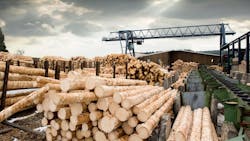Can Domestic Lumber Production Keep Up With Demand?
With tariffs on Canadian lumber, there has been a greater push for U.S. sawmills to boost their lumber production. However, according to the National Association of Home Builders, utilization rates of U.S. sawmills are falling, meaning mills technically have the capacity to make more lumber but aren’t doing so. Among the reasons: many mills have reduced employment over the years and don’t have enough workers to produce at higher levels. Additionally, high prices and a more recent lack of foreign competition have removed much of the incentive to boost domestic production of lumber in favor of profitability.
Production capacity has actually grown since 2017, but actual output levels have not. Since the beginning of the year, U.S. sawmills have shown low production and falling utilization rates, which averaged 64.4% in Q1 2025.
Based on the data above, sawmill capacity has increased from 2015 but remains lower than peak levels in 2011. Most of the recent capacity gains took place in 2023, followed by little gain over the course of 2024. As evident above, there is ample room to increase production of domestic lumber, but current production levels remain much unchanged over the past several years. Looking at the Producer Price Index, lumber prices remain higher than 2024. At current pricing levels, producers may see no benefit of increasing output, as it would push prices lower since demand has fallen from the start of the year. Notably, even when prices were historically high in 2021 and 2022, producers were unable to increase their production significantly during these periods, potentially due to supply chain disruptions.
